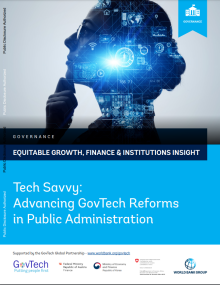Global Program on GovTech & Public Sector Innovation
Publications
-
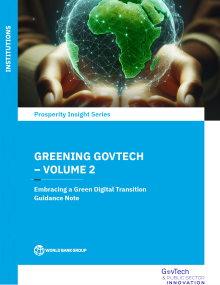 Embracing a Green Digital Transition: Greening GovTech, Volume II
Embracing a Green Digital Transition: Greening GovTech, Volume IIThis note explores how governments can balance digital innovation with climate action. Showcasing case studies from Albania, Brazil, and Germany, it introduces the Greening GovTech Measurement Approach (GGMA) to assess environmental trade-offs. The publication offers guidance for policymakers, practitioners, and stakeholders committed to advancing sustainable, citizen-centered digital government.
-
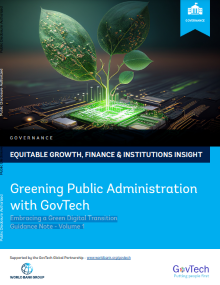 Greening Public Administration with GovTechEmbracing a Green Digital Transition Guidance Note - Volume 1
Greening Public Administration with GovTechEmbracing a Green Digital Transition Guidance Note - Volume 1Governments are increasingly seeking opportunities to leverage digital technologies to build a greener future. This guidance note provides useful advice to policy makers underlining adequate leadership and commitment are crucial to implement coordinated GovTech and Green policies. The climate change impacts of digitalization can provide the benefits of green digital service delivery, paperless administration, and the efficiency of integrated services for a reduction of the carbon footprint.
-
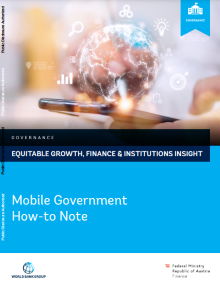 Mobile Government How-To Note
Mobile Government How-To NoteMobile government (mGov) offers enormous opportunities to connect citizens to their governments. Ninety-five percent of the world’s population now has access to a mobile network. Whether via simple, low-tech feature phones or high-tech smartphones, through quick-win solutions or comprehensive approaches, the mobile government offers enormous opportunities—but implementation also presents challenges. This How-to Note offers strategies for making the most of these opportunities and overcoming related challenges.
-
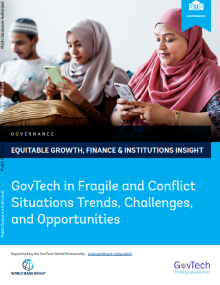 GovTech in Fragile and Conflict Situations Trends, Challenges, and Opportunities
GovTech in Fragile and Conflict Situations Trends, Challenges, and OpportunitiesThis report takes stock of the development of GovTech solutions in Fragile and Conflict-Affected Situations (FCS), be they characterized by low institutional capacity and/or by active conflict and provides insights on challenges and opportunities for implementing GovTech reforms in such contexts. It is aimed at practitioners and policy makers working in FCS but will also be useful for practitioners working in Fragility, Conflict, and Violence (FCV) contexts, at-risk countries, or low-income countries as some similar challenges and opportunities can be present.
-
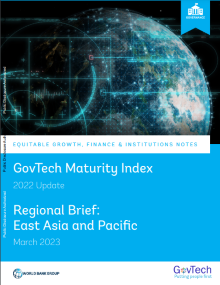 GovTech Maturity Index, 2022 Update — Regional Briefs
GovTech Maturity Index, 2022 Update — Regional BriefsA series of regional briefs were prepared in consultation with the World Bank regional units and country teams to complement the GovTech Maturity Index (GTMI) 2022 Update. They present an overview of the progress in GovTech maturity within the last two years, along with the good practices, gaps, and opportunities for accelerating public sector digital transformation. These briefs were published as EFI Notes to complement the “GTMI 2022 Update: Trends in Public Sector Digital Transformation” report.
-
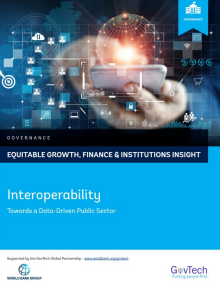 Interoperability: Towards a Data-Driven Public Sector
Interoperability: Towards a Data-Driven Public SectorInteroperability frameworks are a key enabler for GovTech, the World Bank’s whole-ofgovernment approach to public sector modernization, as they reduce system boundaries between government agencies by setting standards and guidelines across government systems to allow for seamless exchange of information and communication between systems. But governments may face several challenges when setting up and implementing interoperability frameworks, related to a mix of technical, semantic, legal, organizational, and cultural factors.
This How-to Note provides advice on what interoperability in the public sector is, why it is needed and how it can be implemented with various examples and a whole-of-government approach to interoperability taking into account both digital and nondigital aspects is of the essence. -
Tech Savvy : Advancing GovTech Reforms in Public Administration
GovTech is one strategy that governments have adopted to more effectively respond to citizen needs and improve the effectiveness and efficiency of public service delivery. Yet, all too often a government’s information and communications technology (ICT) projects do not deliver on their promise, and the public sector has a history of projects falling short of expectations, going over time and budget and taking years to deliver on their potential. There are a number of challenges that need to be overcome for GovTech solutions to work, and this report focuses on three key challenges that the World Development Report (WDR) 2016 called the analog complements, which underpin effective digital transformation in the public sector: a whole-of-government coordination, civil service digital skill development, and an innovative culture in public sector organizations. This report focuses on three key analogue complements that can get in the way of successful GovTech projects: coordination, capacity, and culture.
-
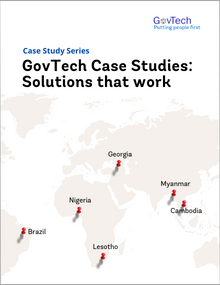 GovTech Case Studies: Solutions that WorkCase Study Series
GovTech Case Studies: Solutions that WorkCase Study SeriesA series of GovTech case study notes — GovTech Case Studies: Solutions that Work — provides a better understanding of GovTech focus areas by introducing concrete experiences of adopting GovTech solutions, lessons learned and what worked or did not work. Read the set of case studies which explores GovTech solutions implemented in Djibouti, India, Jordan, Tunisia, Brazil, Cambodia, Georgia, Lesotho, Myanmar, and Nigeria.
- SUMMARY INFOGRAPHIC
- Djibouti: Digital Customs Administration Using ASYCUDAWorld
- India: Public Finance Institutional Reforms using GovTech Solutions as an Enabler in Assam State
- Jordan: The SANAD Portal for Digital Government Services
- Tunisia: Problem-Driven and Adaptive Approach for Citizen-Centric Service Delivery
- Brazil: The SOL-ution for Smart Community Procurement
- Cambodia: Maximizing the Benefits of FMIS
- Georgia: Promoting Digital Transformation through GovTech
- Lesotho: The National Identification System
- Myanmar: Mobile Phones for Maternal and Child Cash Transfers
- Nigeria: Participatory Governance to Strengthen the Social Contract in Kaduna State
-
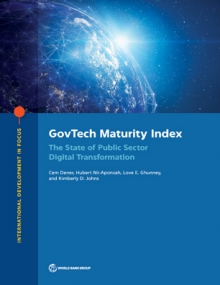 GovTech Maturity Index(GTMI): The State of Public Sector Digital Transformation
GovTech Maturity Index(GTMI): The State of Public Sector Digital TransformationThe GovTech Maturity Index provides a global snapshot of GovTech maturity, along with a diverse set of good practice examples and entry points for enhancing technology. It is a composite index that uses 48 key indicators. This report provides a comprehensive review of how far 198 nations have come and still need to go. The study specifies areas for improvement so that policy makers and their advisers can make informed decisions on how to tackle specific challenges to advance public sector modernization. Practitioners will also be able to use it as a resource to design new digital transformation projects.
-
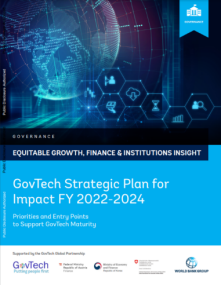 GovTech Strategic Plan for Impact FY2022-2024 : Priorities and Entry Points to Support GovTech Maturity
GovTech Strategic Plan for Impact FY2022-2024 : Priorities and Entry Points to Support GovTech MaturityThe GovTech Strategic Plan for Impact FY2022-2024: Priorities and Entry Points to Support GovTech Maturity provides a GovTech roadmap for the World Bank and the Governance Global Practice. The roadmap reflects evolving client priorities and GovTech team positioning relating the larger digital economy and inclusive economic growth agenda. Read the Paper.
-
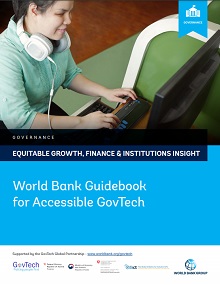 World Bank Guidebook for Accessible GovTech
World Bank Guidebook for Accessible GovTechThe World Bank has committed to supporting the development of universally accessible GovTech in the lower income countries that benefit from resources of the International Development Association (IDA). This guidebook aims to provide development practitioners and governments with steps and actions to mainstream accessibility concerns in the development of GovTech projects and adopt accessibility as a systematic feature of digital solutions in the provision of public services.
-
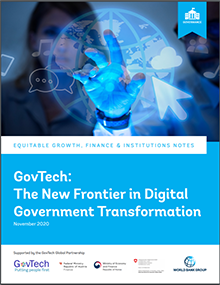 GovTech: The New Frontier in Digital Government Transformation
GovTech: The New Frontier in Digital Government TransformationThis brief introduces GovTech for the World Bank staff and client countries to support public sector modernization using technology. The note helps teams and country officials working on the GovTech agenda by providing a clear definition and clarity on GovTech concepts for use in policy dialogues and operations. The note also provides information on the World Bank’s GovTech Global Partnership (GTGP) that was established in the Spring of 2019.
-
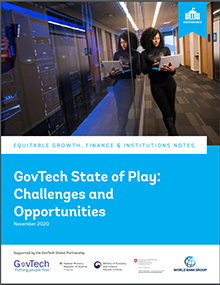 GovTech State of Play: Challenges and Opportunities
GovTech State of Play: Challenges and OpportunitiesThis brief details the current status of our GovTech agenda that aims to support task teams engaging with clients to work on public sector modernization using technology and grappling with how proposed solutions align with the GovTech approach. This note also presents an overview of the GovTech portfolio, and the mapping of existing digital government projects to new areas of GovTech focus. Additionally, considering the progress made toward GovTech’s goal, the note summarizes challenges and opportunities for teams developing GovTech projects.
-
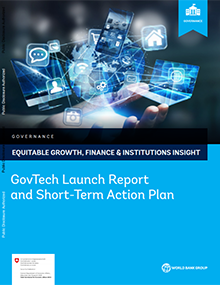 GovTech Launch Report and Short-Term Action Plan
GovTech Launch Report and Short-Term Action PlanThis report presents the work program priorities for the first two years of the World Bank’s GovTech Global Partnership (GTGP), drawing upon the trends in GovTech applications and lessons learned from the last 25 years of the Bank’s support to governments using technology to improve the effectiveness of the public administration and service delivery.
-
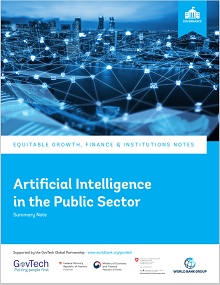 Artificial Intelligence in the Public Sector
Artificial Intelligence in the Public SectorThis note examines the opportunities and challenges of deploying AI in government. As governments confront the economic and health challenges arising from COVID 19, the impact on government’s fiscal stress and mobility limitations on citizens and civil servants are proving to be drivers for governments to find more technologically enabled solutions to improve or continue services and to do so without increasing the costs, and to find ways to cut costs and corruption.
-
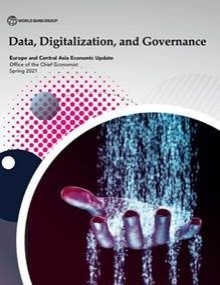 Data, Digitalization, and Governance
Data, Digitalization, and GovernanceThis report summarizes recent developments and presents the outlook for the region. It also focuses on governance, a key development issue in Europe and Central Asia, the importance of which has also been highlighted during the COVID-19 crisis, since government quality, public trust, and credibility are vital elements of success in fighting the pandemic.
-
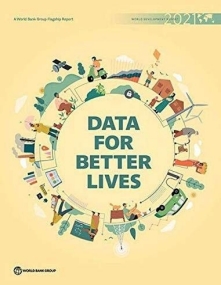 World Development Report 2021: Data for Better Lives
World Development Report 2021: Data for Better LivesThis Report aims to answer two fundamental questions. First, how can data better advance development objectives? Second, what kind of data governance arrangements are needed to support the generation and use of data in a safe, ethical, and secure way while also delivering value equitably?
-
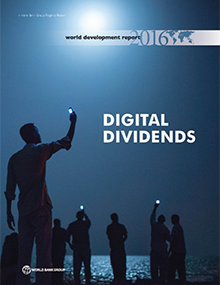 World Development Report 2016: Digital Dividends
World Development Report 2016: Digital DividendsDigital technologies have spread rapidly in much of the world. Digital dividends—that is, the broader development benefits from using these technologies—have lagged behind. In many instances, digital technologies have boosted growth, expanded opportunities, and improved service delivery. To get the most out of the digital revolution, countries also need to work on the “analog complements”—by strengthening regulations that ensure competition among businesses, by adapting workers’ skills to the demands of the new economy, and by ensuring that institutions are accountable. Check out the report.
-
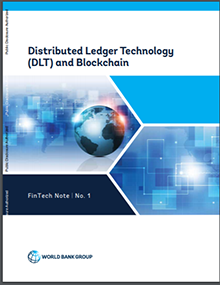 Distributed Ledger Technology and Blockchain
Distributed Ledger Technology and BlockchainThis note on distributed ledger technology (DLT) and blockchains is part of a series of short notes that explore new trends and developments in Fintech and analyze their potential relevance for WBG activities. Forthcoming notes in this series will cover marketplace lending, ‘InsureTech’, and other topics. This note outlines the mechanisms, origins, and key characteristics of DLT.
-
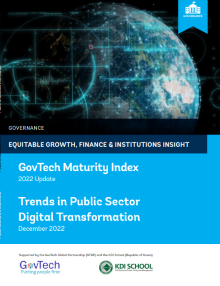 GovTech Maturity Index, 2022 Update: Trends in Public Sector Digital Transformation
GovTech Maturity Index, 2022 Update: Trends in Public Sector Digital TransformationThe 2021 GovTech Maturity Index (GTMI) report, updated biennially, tracks digital transformation and identifies gaps. The 2022 update showcases progress, good practices, and areas for improvement, with economies grouped to reflect global GovTech focus.
-
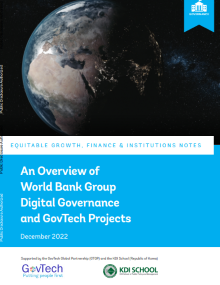 An Overview of World Bank Group Digital Governance and GovTech Projects
An Overview of World Bank Group Digital Governance and GovTech ProjectsThis brief presents an overview of the World Bank Group's Digital Government and GovTech investments over the years. It is intended to complement a database of Digital Government and GovTech projects launched along the GTMI Update in 2022 (insert: https://datacatalog.worldbank.org/search/dataset/0037889/govtech-dataset), and together is intended to inform those working on digital transformation initiatives.
